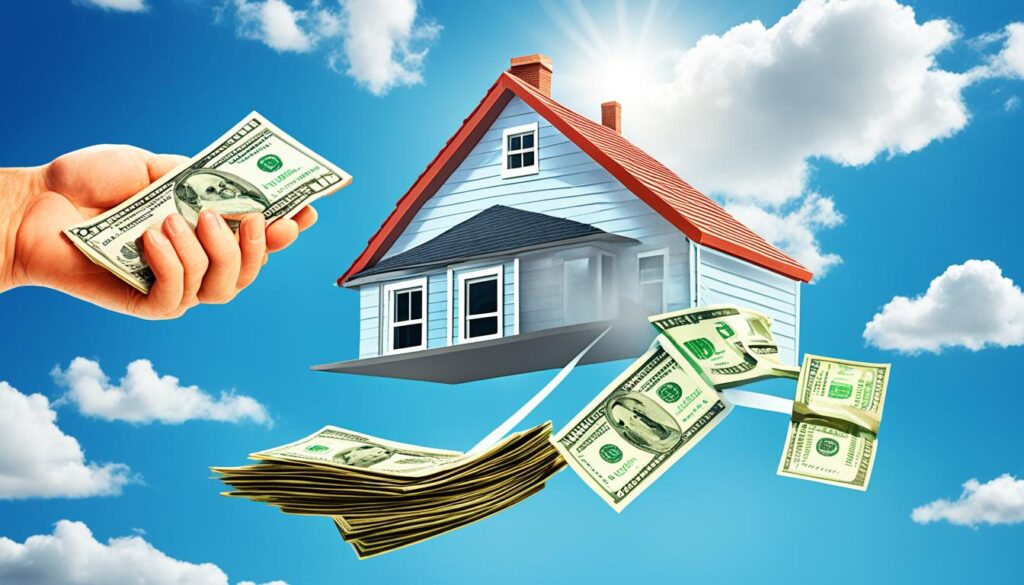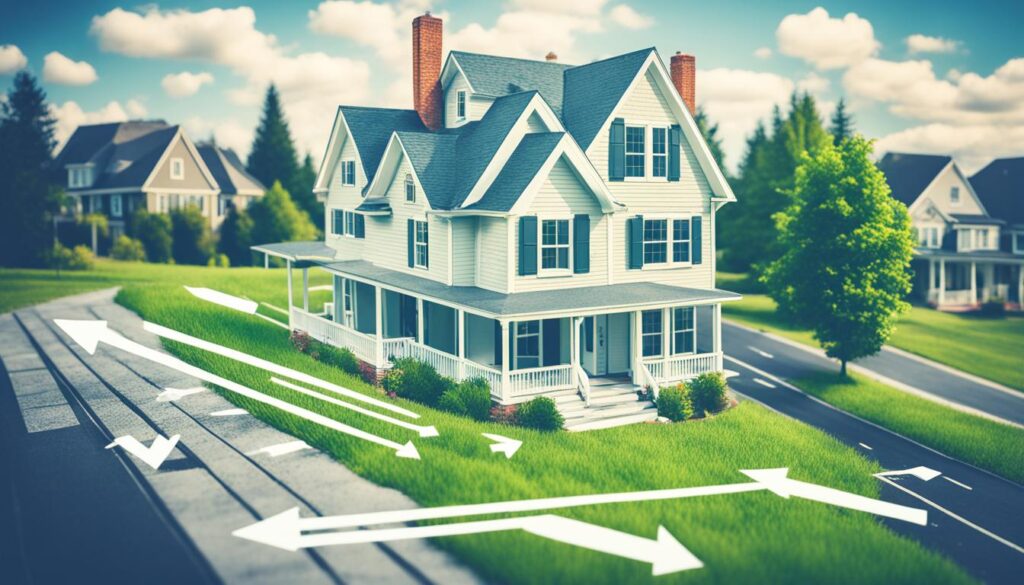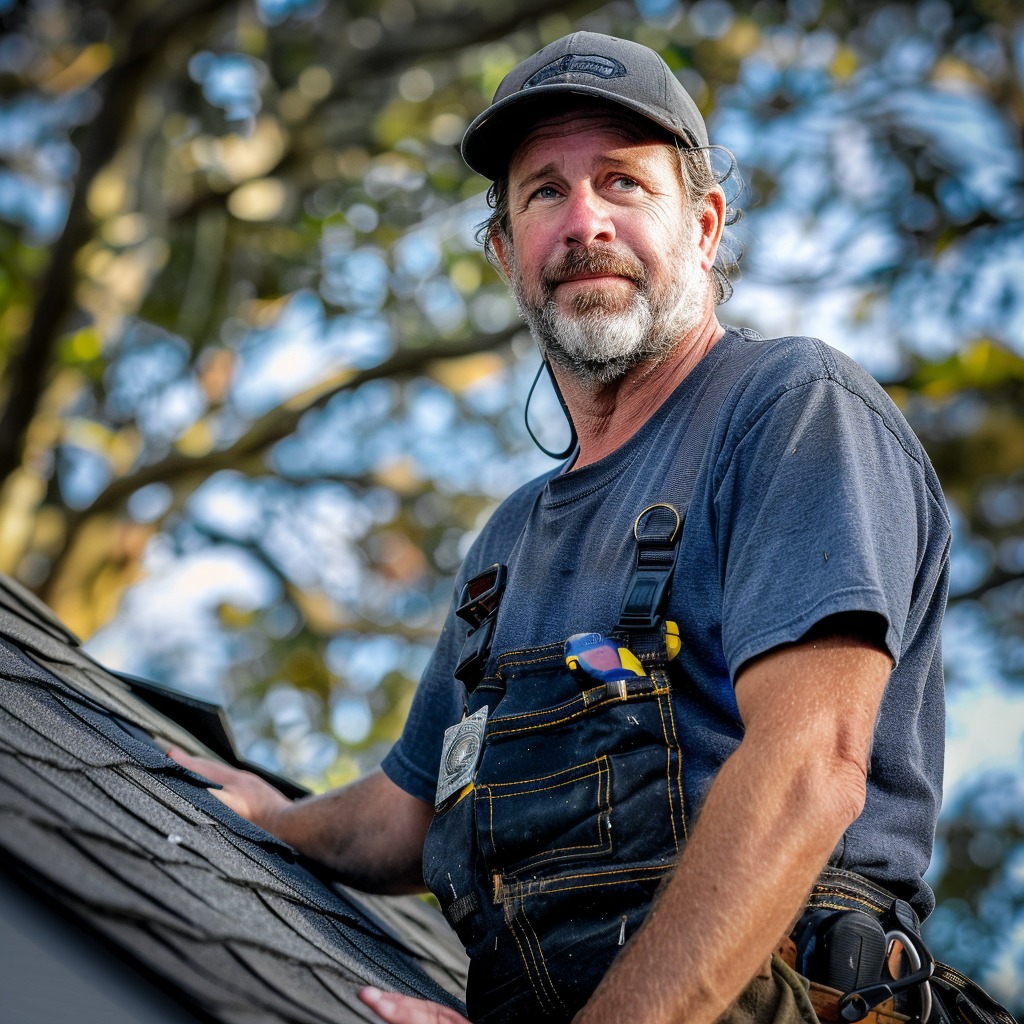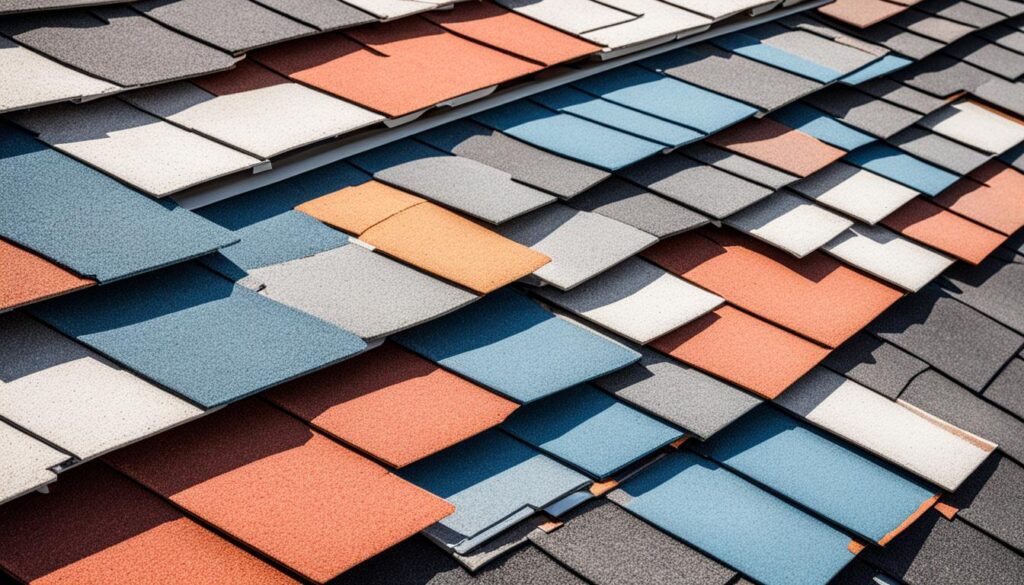Do you know the true value of your roof? As a homeowner, you may be surprised to learn that your roof could be depreciating over time due to wear and tear. This depreciation can have a significant impact on your insurance claims for roof damage. But what if we told you that there is a way to recover some of the depreciation costs? Yes, there is a possibility to receive a second check from your insurance company, but it’s essential to understand how recoverable depreciation works and if your insurance policy offers this coverage.
Recoverable depreciation is a key aspect of roof damage insurance claims that every homeowner should be aware of. It can make a difference in maximizing your potential claim and ensuring that your roof is restored to its full value. In this comprehensive guide, we will explore everything you need to know about recoverable depreciation for roofs and how it can benefit you.
Key Takeaways:
- Recoverable depreciation refers to the lost value of your roof over time due to wear and tear.
- Understanding recoverable depreciation can help homeowners maximize their insurance claims for roof damage.
- Not all insurance policies offer recoverable depreciation, so it’s essential to know if your policy includes this coverage.
- The type of insurance policy you have, such as Actual Cash Value (ACV) or Replacement Cost Value (RCV), affects the availability of recoverable depreciation.
- To avoid insurance fraud, it’s crucial to follow the proper claim process and work with reputable professionals.
What is Recoverable Depreciation?
Recoverable depreciation is an important concept to understand when filing an insurance claim for roof damage. It refers to the amount of value that your roof has lost over time due to wear and tear. When assessing the damage to your roof, insurance companies take into account this depreciated value. Depending on your insurance policy, you may be eligible to receive recoverable depreciation as a second check from your insurance company.
Recoverable depreciation is calculated as the difference between the current value of your roof and its depreciated value. This means that even if your initial claim check is based on the depreciated value of your roof, you may still be able to recover the difference.
Understanding how recoverable depreciation works is crucial for maximizing your insurance claim for roof damage. By knowing the extent of the recoverable depreciation and the eligibility requirements set by your insurance policy, you can ensure that your claim covers the necessary repairs or roof replacement.
Filing an insurance claim for roof damage can be complicated, so it’s important to consult with a professional roofing contractor and review your policy to fully grasp the recoverable depreciation process.
Key Points to Remember:
- Recoverable depreciation is the difference between the current value and depreciated value of your roof.
- Insurance policies may offer recoverable depreciation as a second check.
- Understanding the recoverable depreciation process is vital for maximizing your insurance claim.
Example Table: Recoverable Depreciation Calculation
| Roof Value | Depreciated Value | Recoverable Depreciation |
|---|---|---|
| $10,000 | $7,000 | $3,000 |
Which Insurance Policy Offers Recoverable Depreciation?
The availability of recoverable depreciation depends on the type of insurance policy you have. There are two main types of policies to consider – the Actual Cash Value (ACV) policy and the Replacement Cost Value (RCV) policy.
Actual Cash Value (ACV) Policy:
An ACV policy is a type of insurance policy that takes into account the depreciated value of your roof at the time of the claim. When filing a roof damage claim with an ACV policy, your insurance company will pay out the depreciated value of your roof, which is typically lower than the replacement cost. This means that if your roof is damaged and needs repair or replacement, you will receive a payout based on the current value of your roof minus the depreciation.
Replacement Cost Value (RCV) Policy:
An RCV policy, on the other hand, provides coverage for the full cost of roof replacement. With this type of policy, the insurance company will pay the actual cost of replacing your damaged roof, without deducting for depreciation. This means that if your roof is damaged and needs repair or replacement, you will receive a payout that covers the entire cost of replacing your roof, without considering depreciation.
If you have an RCV policy, you may be eligible to receive recoverable depreciation after completing the necessary repairs or roof replacement. This means that you can recover the depreciated value of your roof on top of the initial payout for the replacement cost.
It is important to review your insurance policy and understand which type of policy you have before filing a roof damage claim. Knowing whether your policy offers recoverable depreciation can help you maximize your insurance claim and ensure that you receive the appropriate coverage for your roof replacement.
Comparison of ACV and RCV Policies
| Policy Type | Payment Calculation | Recoverable Depreciation Eligibility |
|---|---|---|
| Actual Cash Value (ACV) Policy | Pays out the depreciated value of the roof at the time of the claim | Not typically eligible for recoverable depreciation |
| Replacement Cost Value (RCV) Policy | Covers the full cost of roof replacement without deducting for depreciation | Eligible for recoverable depreciation after completing repairs or roof replacement |
By understanding the differences between ACV and RCV policies and knowing which type of policy you have, you can make informed decisions when filing a roof damage claim. If you have an RCV policy, you can take advantage of recoverable depreciation to recover the depreciated value of your roof on top of the initial payout for the replacement cost.
How Does Recoverable Depreciation Work for a Roof Damage Claim?
When it comes to filing a roof damage claim with an insurance company that offers recoverable depreciation, understanding the process is crucial. Here’s how it works:
- Step 1: Assessment of Work Needed
- Step 2: Initial Payment
- Step 3: Holding Back Recoverable Depreciation
- Step 4: Completion of Repairs or Roof Replacement
- Step 5: Proof of Work
- Step 6: Second Payment
Your insurance company will conduct an assessment of the scope of work required to restore your roof. Based on their evaluation, they will provide an estimate for the necessary repairs or roof replacement.
Once the assessment is complete, your insurance company will issue an initial check for the actual cash value (ACV) of your roof. This payment represents the depreciated value of your roof at the time of the claim.
Along with the initial payment, your insurance company will hold back the recoverable depreciation amount. This portion of the claim is the difference between the depreciated value and the cost of repairing or replacing your roof.
After you complete the necessary repairs or roof replacement, it is crucial to keep records and documentation of the work done as per the claim requirements. This documentation will be used to validate the second payment.
Once the repairs or roof replacement is completed, you or your roofing contractor will provide proof of the work done to the insurance company. This can include invoices, receipts, and photos demonstrating the completed repairs or replacement.
If everything checks out and the work aligns with the claim, the insurance company will issue a second check to cover the recoverable depreciation amount. This payment will be sent to you and will cover the remaining costs of the repairs or roof replacement.
By following the claim process correctly and providing the necessary proof of work, you can maximize your potential recoverable depreciation for roof repairs or replacement. It’s essential to keep accurate records and work with reputable roofing contractors to ensure a smooth claim process.

When it comes to recoverable depreciation for roof damage claims, understanding the process is key to achieving a successful claim. By working with your insurance company and providing proof of the completed work, you can maximize your recoverable depreciation and ensure your roof is restored to its full value.
How to Avoid Committing Insurance Fraud with Recoverable Depreciation
To avoid committing insurance fraud when claiming recoverable depreciation, it’s crucial to ensure that the work is done correctly and in line with the claim paperwork. This requires hiring a reputable roofing contractor who understands the insurance process and can provide the necessary documentation for the claim. Both the homeowner and the roofing contractor should be transparent and follow the scope of work outlined in the claim. Attempting to keep extra money by leaving out work or deliberately not following the claim details can lead to insurance fraud. It’s important to work with professionals who have experience with insurance claims to avoid any issues.
When dealing with recoverable depreciation, honesty and transparency are key. If the insurance company suspects fraud or finds inconsistencies between the claimed damage and the actual repairs, your claim may be denied, and legal action could be taken against you. It’s in your best interest to hire a reputable roofing contractor who is familiar with the insurance claim process and can provide the necessary documentation and receipts to support your claim.
| Tips to Avoid Committing Insurance Fraud with Recoverable Depreciation: |
|---|
| 1. Hire a reputable roofing contractor who has experience with insurance claims and can provide proper documentation. |
| 2. Be transparent and honest with your insurance company about the scope of work needed and the repairs or replacement required. |
| 3. Follow the claim paperwork and ensure that the work done aligns with the claim’s requirements. |
| 4. Keep detailed records of all communication, receipts, and invoices related to the repairs or replacement. |
| 5. Avoid inflating the cost of repairs or including unnecessary work just to receive more money. |
| 6. Do not attempt to file multiple claims for the same damage or submit false documentation. |
By following these tips and working with professionals who understand the insurance claim process, you can avoid committing insurance fraud and ensure a smooth and successful claim for recoverable depreciation on your roof.

What You Need to Know About the Insurance Claim Process for Roof Damage
Understanding the entire insurance claim process for roof damage is crucial for homeowners seeking to recover their losses. While recoverable depreciation is an important aspect of the process, there are several other key factors to consider when filing a claim.
When initiating a roof damage claim, it’s essential to gather all the required documentation to support your case. This may include photographs of the damage, invoices for previous repairs, and any applicable insurance policy details. By providing accurate and comprehensive documentation, you can strengthen your claim and increase the likelihood of a successful recovery.
The timeline for repairs is another significant factor to consider. Depending on the extent of the damage, it may take some time to complete the necessary repairs or roof replacement. It’s essential to communicate with your insurance company and keep them updated on the progress of the repairs. By doing so, you can ensure a smooth claims process and avoid any potential delays.
Throughout the claim process, homeowners will need to interact with their insurance company. It’s important to establish clear lines of communication and maintain a detailed record of all conversations and correspondences. By keeping accurate documentation, you can reference key discussions and agreements should any issues arise during the claims process.
To navigate the insurance claim process successfully, it’s beneficial to work with a roofing contractor experienced in handling insurance claims. These professionals can guide you through the process, ensuring that all necessary steps are taken and that your roof receives the coverage it deserves. They can also help you understand the intricacies of the recoverable depreciation aspect, maximizing your potential recovery for storm-damaged roofs.
Remember, familiarity with the insurance claim process and collaboration with experts in the field can significantly increase your chances of a successful roof damage claim. Stay organized, communicate effectively, and seek professional assistance to facilitate the recoverable depreciation for your storm-damaged roof.
This image visually represents the importance of understanding the insurance claim process and the potential recovery that can be achieved for storm-damaged roofs.
Conclusion
Understanding the concept of recoverable depreciation is crucial for homeowners looking to maximize their insurance claim for roof damage. By familiarizing themselves with how recoverable depreciation works and which insurance policies offer it, homeowners can ensure they receive the full coverage they are entitled to. Additionally, it is important to avoid committing insurance fraud by following the claim process correctly and working with reputable professionals.
Recoverable depreciation allows homeowners to recover the costs associated with roof damage and restore their roofs to their full value. By partnering with experienced roofing contractors who understand the insurance claim process, homeowners can navigate the complexities of filing a claim and ensure that their roofs are properly restored.
To make the most of recoverable depreciation, homeowners should document and provide all necessary paperwork and evidence to their insurance company. This includes the scope of work, detailed receipts, and proof of completed repairs or roof replacement. By following the correct claim process and working with professionals, homeowners can maximize their potential recoverable depreciation and ensure a successful insurance claim.

Meet William Adams, a seasoned roofing expert with over 30 years of hands-on experience in the industry. Having worked tirelessly under the scorching sun and through the fiercest storms, William brings a wealth of knowledge and expertise to the table. Hailing from the heart of the USA, he’s witnessed the evolution of roofing practices firsthand, mastering every aspect along the way. Now retired from the field, William spends his days cherishing time with his loved ones while sharing his invaluable insights through this platform. With William at the helm, you can trust that every tip, advice, and recommendation provided is backed by years of real-world experience and unwavering dedication to quality craftsmanship. Join us as we journey through the world of roofing, guided by the wisdom and passion of a true industry veteran.

